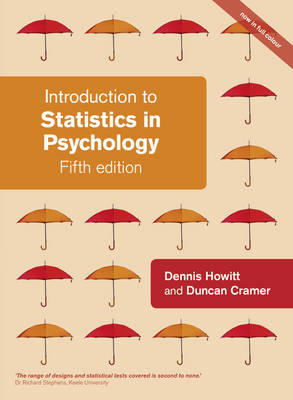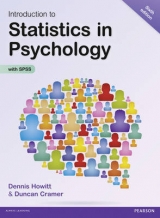
Introduction to Statistics in Psychology
Prentice-Hall (Verlag)
978-0-273-73430-7 (ISBN)
- Titel erscheint in neuer Auflage
- Artikel merken
Revised and updated throughout, the text offers clear and detailed coverage of the statistical methods used by psychologists.
Key aspects of the process are highlighted throughout the text in special sections:
'Research Design Issues' offers advice and guidance on important topics and concepts.
'Examples from the published literature' highlight how tests have been applied in interesting classic and more recent research.
'Calculation' presents and separates out the mathematical principles underlying the analyses.
'Quick Steps Guide' - this new feature offers a practical, quick guide on how to carry out a statistical analysis in SPSS Statistics and helps students understand the links between the different tests.
This book is supported by a companion website featuring a range of resources to help students in their studies. Self test questions, additional datasets and plus handy quick guides to carrying out tests can all be found at www.pearsoned.co.uk/howitt
"Howitt and Cramer's "Introduction to Statistics in Psychology" maintains its lead as the best textbook in what is the most difficult area of study for most psychology students. Indeed, it is more than an 'introduction' - its' clear and comprehensive coverage of statistical analysis from basic descriptive and bivariate techniques to multivariate methods will be a priceless resource for students throughout all years of study." Ronnie Wilson, University of Ulster
Guided tour
Introduction
List of figures
List of tables
List of boxes
Acknowledgements
Part 1: Descriptive statistics
1. Why you need statistics: Types of data
2. Describing variables: Tables and diagrams
3. Describing variables numerically: Averages, variation and spread
4. Shapes of Distributions of Scores
5. Standard deviation and z-scores: The standard unit of measurement in statistics
6. Relationships between two or more variables: Diagrams and tables
7. Correlation coefficients: Pearson correlation and Spearman's rho
8. Regression: Prediction with precision
Part 2: Significance testing
9. Samples and populations: Generalising and inferring
10. Statistical significance for the correlation coefficient: A practical introduction to statistical inference
11. Standard error: The standard deviation of the means of samples
12. The t-test: Comparing two samples of correlated/related/paired scores
13. The t-test: Comparing two samples of unrelated/uncorrelated scores
14. Chi-square: Differences between samples of frequency data
15. Probability
16. Reporting significance levels succinctly
17. One-tailed versus two-tailed significance testing
18. Ranking tests: Nonparametric statistics
Part 3: Introduction to analysis of variance
19. The variance ratio test: The F-ratio to compare two variances
20. Analysis of variance (ANOVA): Introduction to the one-way unrelated or uncorrelated ANOVA
21. Analysis of variance for correlated scores or repeated measures
22. Two-way analysis of variance for unrelated/uncorrelated scores: Two studies for the price of one?
23. Multiple comparisons in ANOVA: Just where do the differences lie?
24. Mixed-design ANOVA: Related and Unrelated Variables together
25. Analysis of covariance: Controlling for additional variables
26. Multivariate Analysis of Variance (MANOVA)
27. Discriminant (Function) analysis especially in MANOVA
28. Statistics and the analysis of experiments
Part 4: More advanced correlational statistics
29. Partial correlation: Spurious correlation, third or confounding variables, suppressor variables
30. Factor analysis: Simplifying complex data
31. Multiple regression and multiple correlation
32. Path analysis
33. The analysis of a questionnaire/survey project
Part 5: Assorted advanced techniques
34. The size of effects in statistical analysis: Do my findings matter?
35. Meta-analysis: Combining and exploring statistical findings from previous research
36. Reliability in scales and measurement: Consistency and agreement
37. Confidence intervals
38. The influence of moderator variables on relationships between two variables
39. Statistical power analysis: getting the sample size right
Part 6: Advanced qualitative or nominal techniques
40. Log-Linear Methods: The analysis of complex contingency tables
41. Multinomial logistic regression: Distinguishing between several different categories
42. Binomial Logistic Regression
Appendices
Appendix A: Testing for excessively skewed distributions
Appendix B1: Large sample formulae for the nonparametric tests
Appendix B2: Nonparametric tests for three or more groups
Appendix C: Extended table of significance for the Pearson correlation coefficient
Appendix D: Table of significance for the Spearman correlation coefficient
Appendix E: Extended table of significance for the t-test
Appendix F: Table of significance for Chi-square
Appendix G: Extended table of significance for the sign test
Appendix H: Table of significance for the Wilcoxon Matched Pairs Test
Appendix I: Table of significance for the Mann-Whitney U-test
Appendix J: Table of significance values for the F-distribution
Appendix K: Table of significant values oft when making multiple t-tests
Glossary
References
Index
| Erscheint lt. Verlag | 25.11.2010 |
|---|---|
| Verlagsort | Harlow |
| Sprache | englisch |
| Maße | 196 x 265 mm |
| Gewicht | 1590 g |
| Themenwelt | Geisteswissenschaften ► Psychologie ► Test in der Psychologie |
| Mathematik / Informatik ► Mathematik ► Statistik | |
| ISBN-10 | 0-273-73430-X / 027373430X |
| ISBN-13 | 978-0-273-73430-7 / 9780273734307 |
| Zustand | Neuware |
| Haben Sie eine Frage zum Produkt? |
aus dem Bereich



